Fibre Access That Actually Makes Sense
Right, passive optical networks. PON stuff. Now I know what you’re thinking – this sounds dead boring compared to all the DWDM kit we’ve been messing about with. But honestly, you’d be wrong there. This technology’s actually changing how service providers get broadband to people’s houses.
You can’t do proper broadband over copper anymore. Just can’t. DSL falls over after a couple of miles from the exchange. Cable gets rubbish when everyone’s streaming Netflix at teatime. Wireless? Coverage is patchy and it doesn’t scale when you’ve got thousands of customers.
Fibre to the house sorts it out, but point-to-point fibre costs an absolute fortune. Think about it – individual fibres to every customer? Your digging costs alone would bankrupt you.
So PON does something clever. One fibre from the exchange, split it passively to serve loads of customers. No active kit in street cabinets. No power needed at the splitters. Just glass splitters that sit there for twenty-odd years doing their job.
This isn’t just theory either. Most new fibre builds use PON these days. BT does. Virgin’s doing it. All these new alternative providers building passive optical networks everywhere – they’re all using PON.
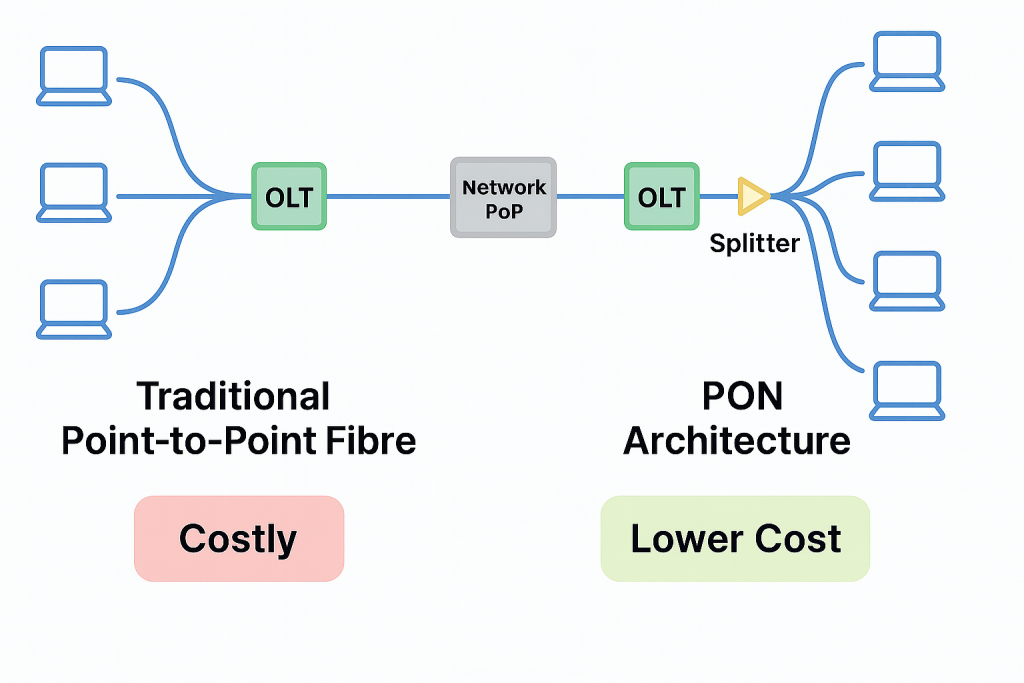
Why Passive Optical Networks Actually Work
Traditional broadband networks need powered kit everywhere. DSL needs DSLAM equipment. Cable needs amplifiers every few hundred metres. Even point-to-point fibre needs switches dotted about.
Active Networks Are a Pain
Active kit needs power constantly. Street cabinets need mains electricity, batteries, often cooling fans. Power goes off, customers lose service. Kit breaks, you need engineers crawling about fixing stuff.
Maintenance becomes a nightmare. Thousands of sites to monitor. Spare parts everywhere. Someone’s got to get access when things break. Your costs just keep going up.
Then there’s the planning hassles. Street cabinets need heating, cooling, protection from vandals. Getting permission for powered cabinets is a right faff when you need electricity connections everywhere.
What You Get with PON
PON gets rid of all that active kit between the exchange and customer premises. Optical splitters are just bits of glass – no power needed, don’t generate heat, basically never break.
Fibre lasts twenty-five years easily. Passive splitters don’t fail unless someone takes a pickaxe to them. Your network becomes much more reliable because there’s nothing to go wrong.
Deployment’s simpler too. No planning permission for powered cabinets. No messing about with electricity companies. No environmental compliance paperwork. Just fibre and glass splitters.
Operating costs drop massively. No power bills in the field. No maintenance visits to sites with no equipment. No kit replacement cycles for gear that doesn’t exist.
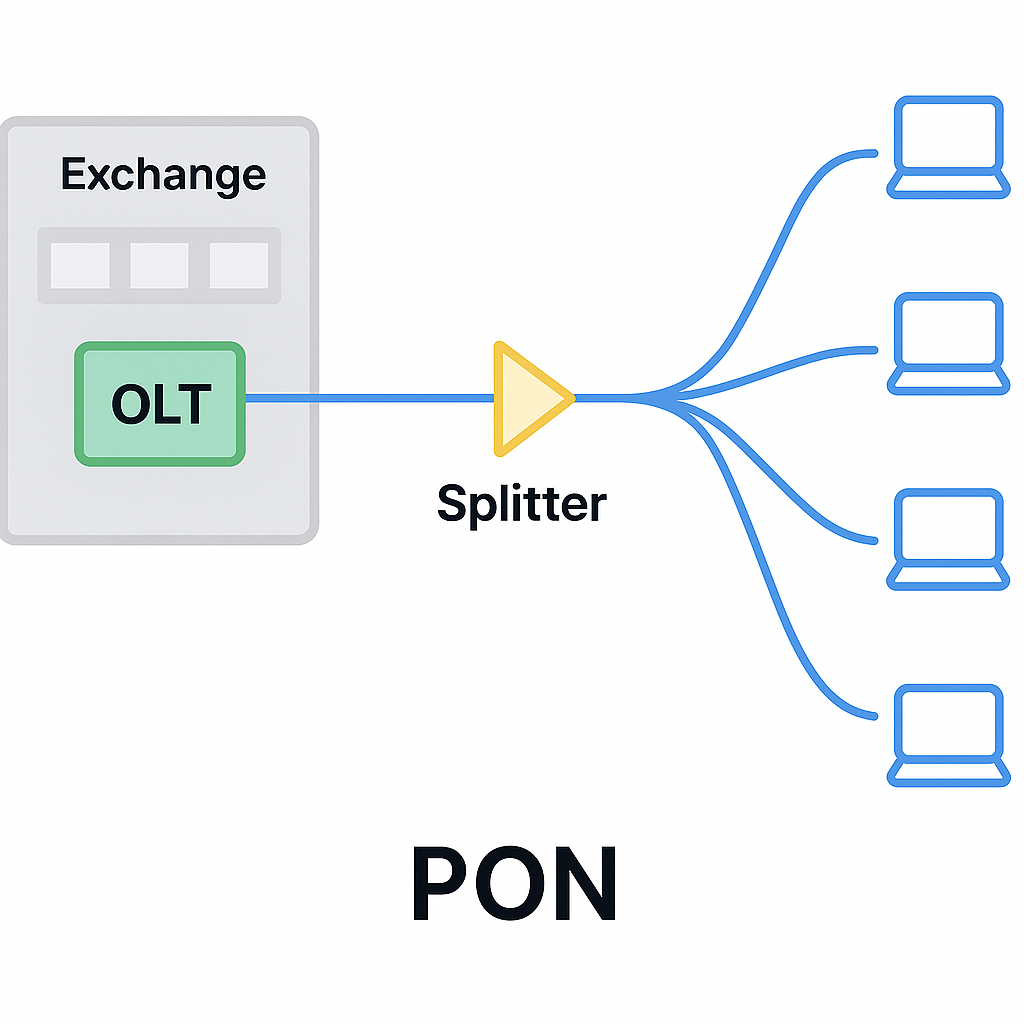
xPON Standards You Need to Know
The “x” just means different types of passive optical networks. Each one targets different uses and gives you different speeds. Let’s look at what matters in passive optical networks.
EPON (Ethernet PON) – IEEE 802.3ah
EPON uses standard Ethernet that’s been tweaked for passive optical networks. Makes sense if you’re already running Ethernet everywhere else.
What you get:
- Speed: 1 Gbps symmetric
- Standard: IEEE 802.3ah
- Wavelengths: 1490 nm down, 1310 nm up
- Splits: Usually 1:16 or 1:32
- Distance: 20 km from OLT to ONT
EPON’s good because it uses the same Ethernet frames you already know. Your existing management tools understand it. Training staff is easier when everything’s the same protocol family.
GPON (Gigabit PON) – ITU-T G.984
GPON gives you higher speeds but they’re asymmetric. Perfect for residential where people download much more than they upload.
What you get:
- Downstream: 2.488 Gbps
- Upstream: 1.244 Gbps
- Standard: ITU-T G.984
- Wavelengths: 1490 nm down, 1310 nm up
- Splits: 1:32, 1:64, even 1:128
- Distance: 20 km
GPON dominates residential because those speeds match how people actually use broadband. Most customers download loads, upload very little. No point wasting upstream capacity nobody uses.
XGS-PON (10G Symmetric PON) – ITU-T G.9807
XGS-PON gives you 10 Gbps both ways. Good for business services and future-proofing residential.
What you get:
- Speed: 10 Gbps symmetric
- Standard: ITU-T G.9807
- Wavelengths: 1577 nm down, 1270 nm up
- Splits: 1:32 or 1:64 usually
- Distance: 20 km
XGS-PON makes sense for business customers who need proper upload speeds. Video calls, cloud backup, collaborative apps – they all need decent upstream.
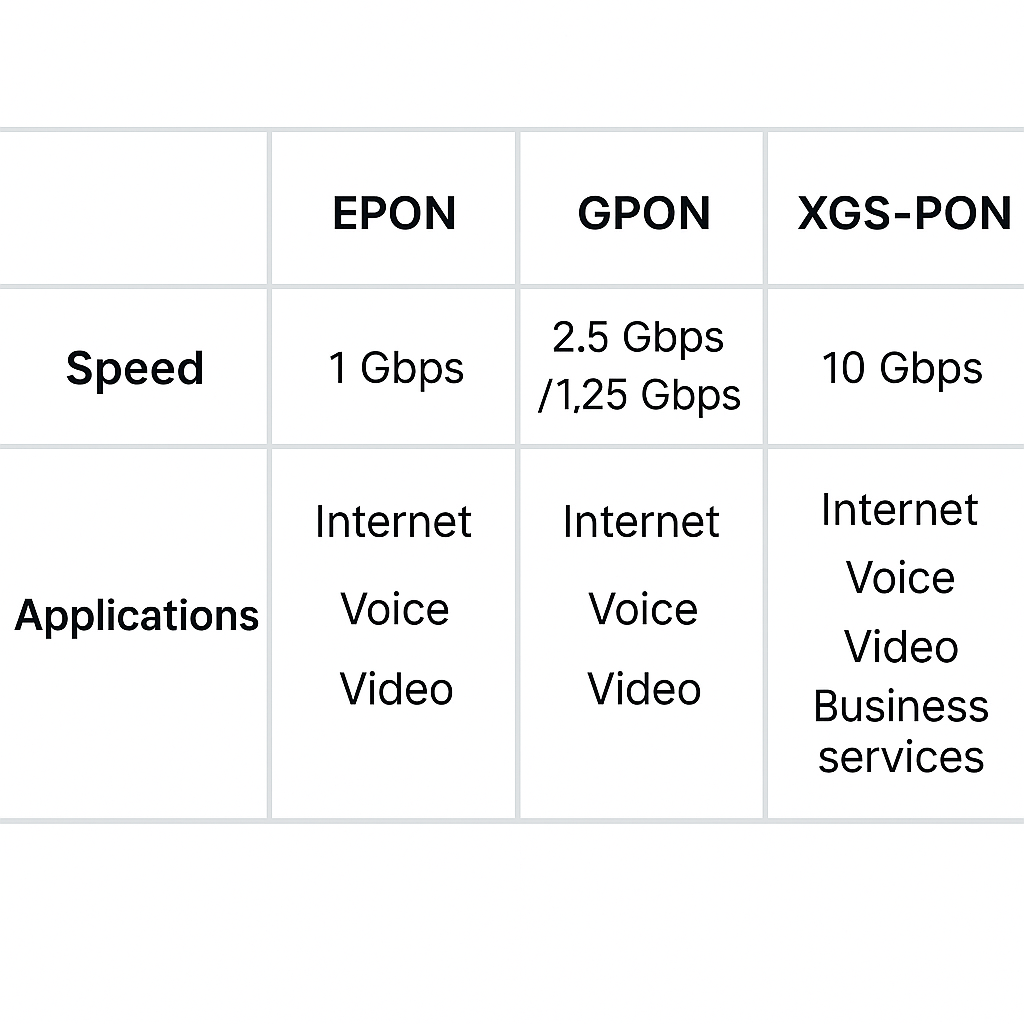
How PON Actually Works
Passive Optical Networks looks simple but there’s clever timing and wavelength stuff happening. You need to understand this when you’re designing or troubleshooting.
Wavelengths in PON
PON uses different wavelengths for upstream and downstream. Means you can have traffic going both ways on one fibre simultaneously.
Standard wavelengths:
- GPON Downstream: 1480-1500 nm continuous
- GPON Upstream: 1260-1360 nm in time slots
- XGS-PON Downstream: 1575-1580 nm continuous
- XGS-PON Upstream: 1260-1280 nm in time slots
- Management: 1625 nm for testing
Downstream’s always transmitting. OLT sends signal constantly even when there’s no data. Makes the ONT receiver simpler and provides timing reference.
Upstream uses time slots. Each ONT gets specific times when it’s allowed to transmit. Without this, upstream signals would crash into each other at the splitter and you’d get chaos.
Ranging – Sorting Out the Timing
ONTs sit at different distances from the OLT. Without compensation, their timing would be all over the shop.
How ranging works:
- Discovery: New ONT powers up, listens for downstream signal
- Registration: ONT sends registration request in a quiet window
- Distance Measurement: OLT measures round-trip delay
- Timing Adjustment: OLT calculates transmission advance needed
- Slot Allocation: ONT gets told its specific time slots
After ranging, all ONTs appear the same distance from the OLT. Close ONT waits longer before transmitting. Far ONT transmits immediately. All signals arrive at the OLT together.
This happens automatically. Connect new customers, ranging just works.
Power Budget Calculations
PON needs careful power management. Signal gets split multiple ways through passive splitters. Each split cuts optical power by about 3 dB.
Where you lose power:
- Fibre loss: 0.25-0.35 dB per kilometre
- Splitter loss: 3 dB per 1:2 split, 15 dB per 1:32 split
- Connector loss: 0.5 dB per connection
- Splice loss: 0.1 dB per fusion splice
- Bending loss: Depends how badly you’ve installed it
Example for GPON 1:32 split:
- OLT sends: +3 dBm
- Fibre loss (10 km): -3.5 dB
- Splitter loss (1:32): -15 dB
- Connections/splices: -2 dB
- ONT receives: -17.5 dBm
ONT receivers work down to -25 dBm, so this gives you decent margin.
Cisco Routed PON Configuration
Cisco’s routed PON gets rid of dedicated PON chassis. Puts OLT functionality into standard routers. Simpler operations, lower costs.
NCS Platform Configuration
NCS 540, NCS 5500, NCS 5700 support XGS-PON through pluggable modules.
Basic setup:
cisco
! Enable PON controller
controller pon 0/0/0/0
pon-type xgs-pon
downstream-fec enabled
upstream-fec enabled
! Configure PON interface
interface pon 0/0/0/0
description "PON Interface - Residential Area A"
encapsulation dot1q
no shutdown
! Configure ONT profiles
ont-profile residential-basic
bandwidth downstream 100000
bandwidth upstream 50000
multicast-profile basic
security-profile standard
ont-profile business-standard
bandwidth downstream 1000000
bandwidth upstream 1000000
multicast-profile business
security-profile high
qos-profile businessIOS-XR Service Configuration
Service provisioning through centralised config:
cisco
! Configure subscriber services
subscriber default
accounting aaa list PON_ACCOUNTING
authentication aaa list PON_AUTHENTICATION
authorization aaa list PON_AUTHORIZATION
template residential-100M
template residential-100M
description "Residential 100M service template"
ipv4 unnumbered Loopback100
ipv6 enable
service-policy input residential-qos-in
service-policy output residential-qos-out
! Dynamic service activation
dynamic-template
type ppp residential-ppp
authentication pap PON_AUTHENTICATION
authorization PON_AUTHORIZATION
accounting PON_ACCOUNTING
ipv4 unnumbered Loopback100
service-policy input residential-qos-in
service-policy output residential-qos-out
! DHCP for PON
dhcp ipv4
profile PON_DHCP_PROFILE server
pool PON_POOL
network 10.100.0.0 255.255.0.0
default-router 10.100.0.1
dns-server 8.8.8.8 8.8.4.4
lease 0 1 0IOS-XE Integration
Traditional IOS-XE works with PON through service interfaces:
cisco
! Enable PON support
service pon
pon-controller gigabitethernet 1/0/0
! Configure logical interfaces
interface PON1/0/0.100
description "PON VLAN 100 - Residential"
encapsulation dot1q 100
ip address 10.100.1.1 255.255.255.0
ip helper-address 10.1.1.10
service-policy input PON_QOS_IN
service-policy output PON_QOS_OUT
interface PON1/0/0.200
description "PON VLAN 200 - Business"
encapsulation dot1q 200
ip address 10.100.2.1 255.255.255.0
service-policy input BUSINESS_QOS_IN
service-policy output BUSINESS_QOS_OUT
! QoS policies
policy-map PON_QOS_IN
class VOICE
priority percent 20
class VIDEO
bandwidth percent 40
class DATA
bandwidth remaining percent 60
policy-map PON_QOS_OUT
class VOICE
priority percent 20
class VIDEO
bandwidth percent 40
class DATA
bandwidth remaining percent 60
shape average 100000000Checking Everything Works
Verification commands:
cisco
# IOS-XR verification
show controller pon 0/0/0/0
show controller pon 0/0/0/0 ont summary
show controller pon 0/0/0/0 ont detail
show controller pon 0/0/0/0 performance-monitoring
# Check ranging and power
show controller pon 0/0/0/0 ont ranging
show controller pon 0/0/0/0 optical-power
# Service verification
show subscriber session summary
show subscriber session location 0/0/0/0
show dhcp ipv4 server binding
# IOS-XE verification
show pon summary
show pon interface PON1/0/0
show pon ont PON1/0/0 summary
show pon ont PON1/0/0 detail id 1Monitor ONT registration, optical power levels, error counters, bandwidth usage.
Protection Options
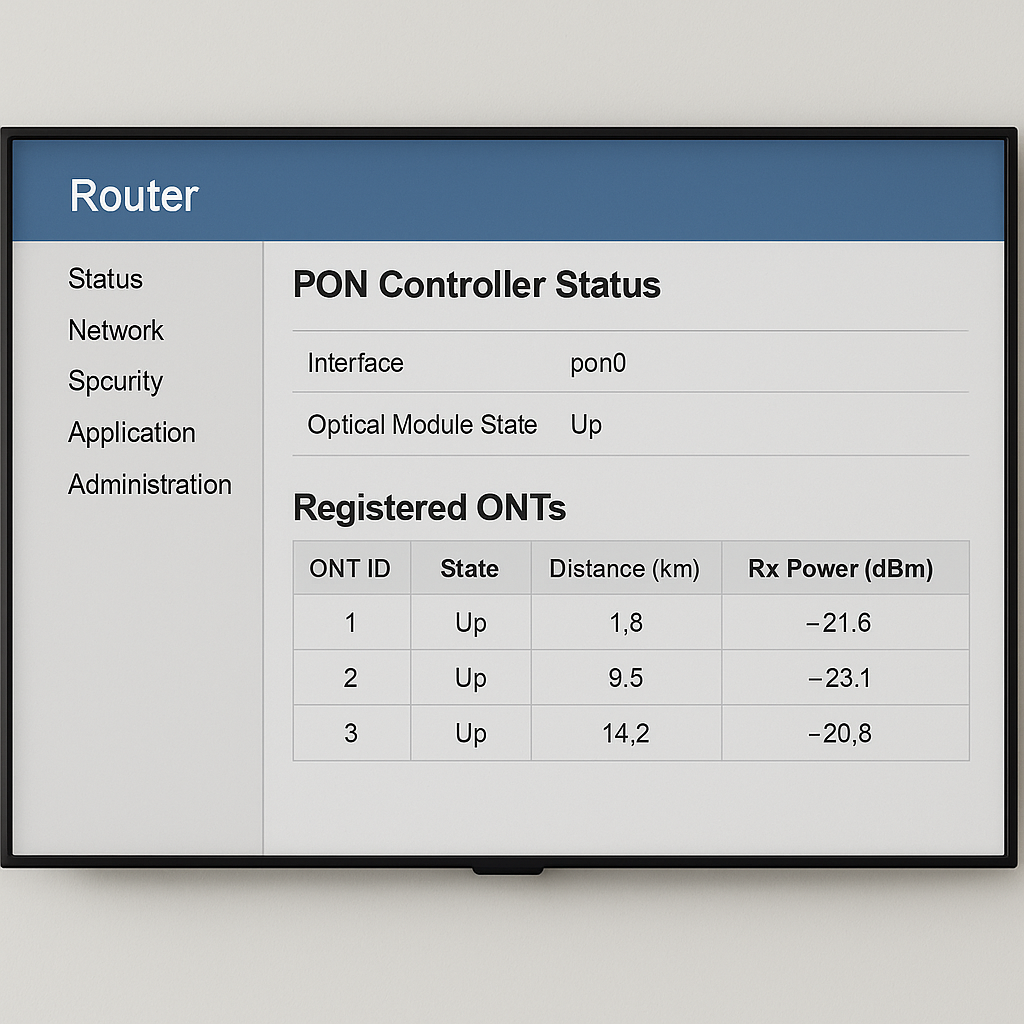
PON supports different protection schemes. Depends what level of service you need and what you want to pay.
Type A Protection
Basic redundancy with duplicate fibres to the splitter.
What you get:
- Single OLT port
- Two fibre paths to splitter
- Passive protection switch at splitter
- No redundancy between splitter and ONT
How it works:
- Primary fibre fails, automatic switch
- Protection switch needs no power
- Service back within seconds
- ONT doesn’t know anything happened
Good for residential where splitter-to-customer failures are rare.
Type B Protection
OLT redundancy with active/standby ports.
What’s protected:
- Two OLT ports on separate cards
- Independent fibres to splitter
- Splitter-to-ONT still single point of failure
- Active/standby switching at OLT
How it behaves:
- Standby monitors primary
- Automatic failover when primary fails
- ONT re-ranges after switchover
- Brief interruption during failover
Better protection against OLT failures, reasonable costs.
Type C Protection
Complete redundancy end-to-end.
Full redundancy:
- Two OLT ports on separate chassis
- Completely separate fibre infrastructure
- Redundant splitters and distribution
- Dual-homed ONTs with protection switching
Protection modes:
- 1+1: Traffic on both paths, ONT picks best
- 1:1: Single active path with standby
Service levels:
- No single points of failure
- Sub-second failover
- Transparent during failures
- Mission-critical business services
Costs much more but gives carrier-grade availability.
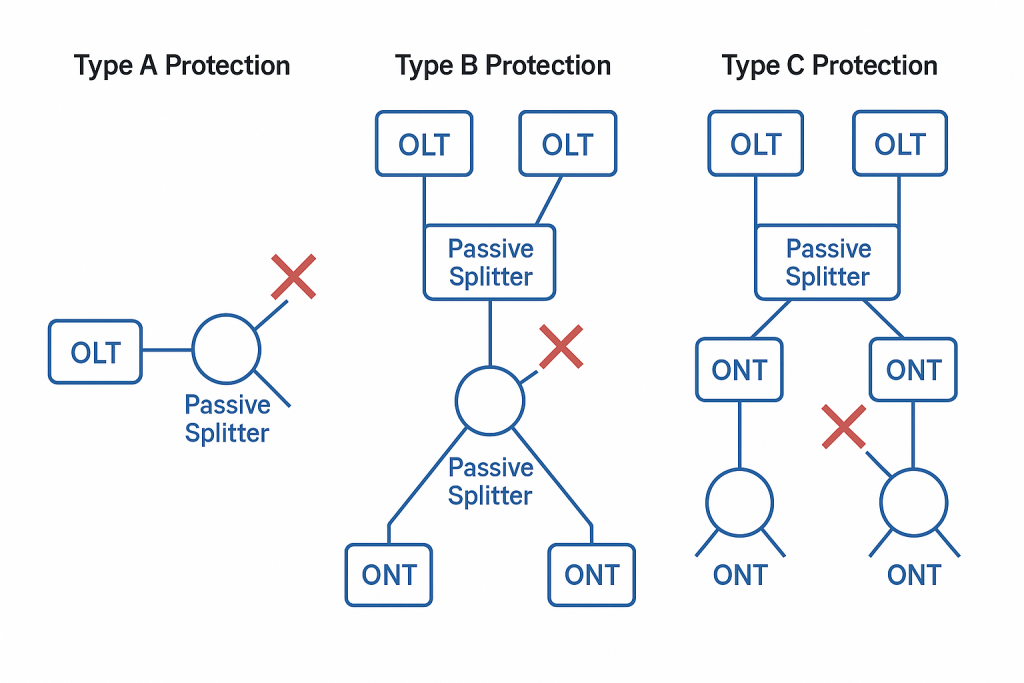
Real Deployments
PON works in loads of different applications. Residential, business, wholesale. Here’s some practical examples.
Housing Estate
Problem: 500 new homes need broadband. Developer wants future-proof kit. Planning won’t allow street furniture.
Solution: GPON with 1:32 splits.
What got built:
- Exchange: NCS 5500 with XGS-PON cards
- Distribution: Underground fibre to 16 splitters
- Customer: GPON ONTs up to 1 Gbps
- Services: Broadband, TV, phone over one fibre
Results:
- Infrastructure cost 40% lower than point-to-point
- Planning much simpler without cabinets
- Service activation dropped from weeks to hours
- Future upgrade path without digging
Operator benefits:
- No field maintenance on passive kit
- Service faults isolated to specific ports
- New services through software updates
- Centralised monitoring
Business Park
Situation: Tech park, 50 businesses, various bandwidth needs, some want symmetric.
Solution: Mixed GPON/XGS-PON with different service levels.
Design:
- Core: NCS 5700 with mixed PON cards
- Standard: GPON up to 2.5 Gbps down
- Premium: XGS-PON 10 Gbps symmetric
- Protection: Type B for critical customers
- Management: Single provisioning platform
Service tiers:
- Bronze: 100/50 Mbps GPON (£100/month)
- Silver: 500/100 Mbps GPON (£200/month)
- Gold: 1000/1000 Mbps XGS-PON (£500/month)
- Platinum: 10000/10000 Mbps XGS-PON (£2000/month)
Results:
- Flexible service levels
- Quick upgrades without site visits
- Lower costs than individual leased lines
- Simplified billing
Mobile Backhaul
Requirements: Mobile operator needs cost-effective small cell backhaul. Low latency, guaranteed bandwidth.
Approach: XGS-PON with strict QoS.
Setup:
- Small cells: XGS-PON ONTs with timing sync
- Aggregation: NCS 540 with PON modules
- Transport: MPLS over PON with traffic engineering
- Timing: 1588v2 PTP over PON
Performance:
- Latency: Under 2ms to mobile core
- Bandwidth: Guaranteed symmetric per site
- Reliability: 99.9% through Type B protection
- Timing: Nanosecond-accurate distribution
Benefits:
- Backhaul costs down 60% versus leased lines
- Faster deployment with passive infrastructure
- Lower operating costs, centralised management
- Scalable for 5G evolution
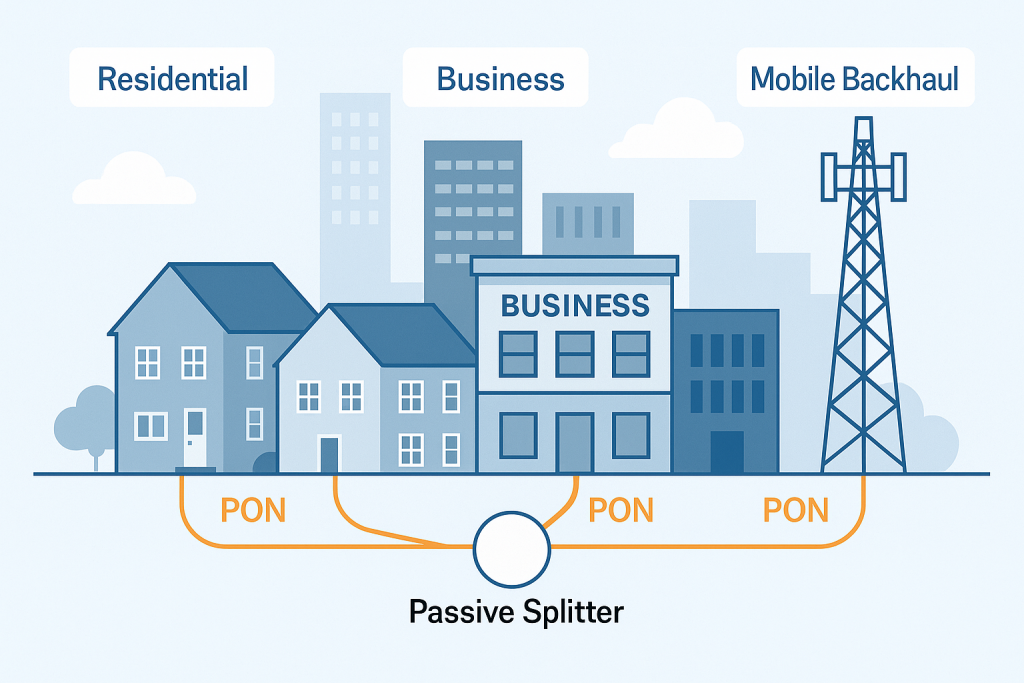
What You Actually Get from PON
PON gives you measurable improvements across multiple areas. Benefits add up over the network lifecycle.
Infrastructure Costs
PON eliminates expensive active electronics from access networks. Traditional broadband needs powered kit every few kilometres. PON just uses passive splitters.
Savings:
- No street cabinets needing electricity
- Less civil engineering for power and cooling
- Fewer planning permissions
- Simpler supply chain with standard components
Cost comparison (1000 customers):
- Point-to-point fibre: £2000 per customer
- Cable system: £800 plus ongoing power
- GPON: £600 with no ongoing power
- XGS-PON: £800 for future-proof capacity
Operating Costs
PON needs minimal ongoing maintenance. Passive components rarely fail. Problems are straightforward to isolate.
Improvements:
- No field power consumption
- Fewer engineer visits through centralised fault management
- Lower spare parts requirements
- Simpler staff training
Annual savings per 1000 customers:
- Power: £0 (passive network)
- Maintenance visits: 80% reduction
- Equipment replacement: 90% reduction in field
- Fault resolution: 50% faster through central diagnostics
Service Delivery
PON enables rapid activation and changes. New customers connect through exchange configuration. Upgrades happen without field visits.
Time improvements:
- New customer: Hours instead of weeks
- Service changes: Minutes through software
- Fault diagnosis: Central testing removes site visits
- Network upgrades: Software-defined capacity
Customer satisfaction improves with faster service delivery.
Revenue Opportunities
PON’s flexible architecture enables new services. Symmetric bandwidth supports business. Multicast enables IPTV. QoS allows service differentiation.
Opportunities:
- Residential triple-play over single fibre
- Business services with guaranteed SLAs
- Wholesale access for other providers
- IoT with specialised service profiles
Revenue per customer increases with comprehensive service portfolios.
Technical Challenges
PON has specific challenges needing careful planning. Understanding limitations helps set realistic expectations.
Optical Power Management
PON works with tight power budgets. Signal splitting reduces power exponentially. High split ratios push power levels near receiver limits.
Issues:
- Split limits: 1:64 splits approach power budget limits
- Distance constraints: 20 km maximum reach limits topology
- Connector quality: Poor connections cause significant loss
- Installation issues: Bad fibre handling degrades signal
How to handle:
- Careful power budget calculations during design
- High-quality connectors and splicing
- Regular optical power monitoring
- Gradual migration from low to high splits
Bandwidth Sharing
PON shares bandwidth among all customers on each port. Unlike point-to-point, customer traffic competes for shared resources.
Implications:
- Peak overlap: Everyone streaming reduces individual throughput
- Upload bottlenecks: Asymmetric PON creates upstream constraints
- Service guarantees: Committed rates need careful oversubscription planning
- QoS complexity: Managing fairness needs proper algorithms
Planning:
- Statistical analysis based on actual usage patterns
- Tiered services with appropriate oversubscription
- Real-time bandwidth monitoring and congestion management
- Regular capacity assessments and expansion
Technology Evolution
PON standards evolve quickly. New generations offer higher speeds but need infrastructure changes. Migration planning critical for long-term success.
Challenges:
- Standards compatibility: Mixing PON generations on same infrastructure
- Equipment lifecycle: Managing OLT and ONT refresh cycles
- Service migration: Moving customers between PON technologies
- Investment protection: Getting value from existing kit
Strategies:
- Wavelength overlay for gradual transitions
- Staged equipment replacement during normal refresh
- Customer communication for service transitions
- Technology roadmap aligned with business requirements
Fault Diagnosis
PON’s shared infrastructure makes fault diagnosis more complex than point-to-point. Problems can affect multiple customers. Root cause analysis needs specialised tools.
Challenges:
- Splitter failures: Single splitter affects many customers
- Fibre cuts: Main feeder damage impacts entire PON port
- ONT problems: Misbehaving customer kit affects other users
- Performance degradation: Intermittent service issues
Approaches:
- Comprehensive OTDR testing capabilities
- Customer traffic analysis and performance monitoring
- Staged testing isolating different network segments
- Correlation analysis across multiple PON ports
So there you have it. PON technology’s a proper shift in access network architecture. Moving from active to passive infrastructure sorts out loads of operational headaches whilst enabling scalable service delivery.
Success means understanding both capabilities and limitations. Careful planning addresses power budgets, bandwidth sharing, fault management. Proper implementation delivers significant cost savings and operational improvements.
Technology’s proven itself in millions of deployments worldwide. UK operators are building PON networks rapidly to meet broadband demand. Alternative providers use PON to compete effectively against incumbent operators.
PON isn’t perfect – no technology is. But for fibre access networks needing cost-effective scalability, passive optical networking gives you compelling advantages over traditional active architectures. Understanding these systems is essential for anyone designing or operating modern access networks.
Don’t be one of those engineers who only looks at the technical specs and ignores the operational reality. You need to understand both the technology and the business case to deploy PON successfully.
External Link: Broadband Stakeholder Group PON Deployment Guide – comprehensive resource covering PON planning, implementation strategies, and operational best practices for UK fibre access networks.
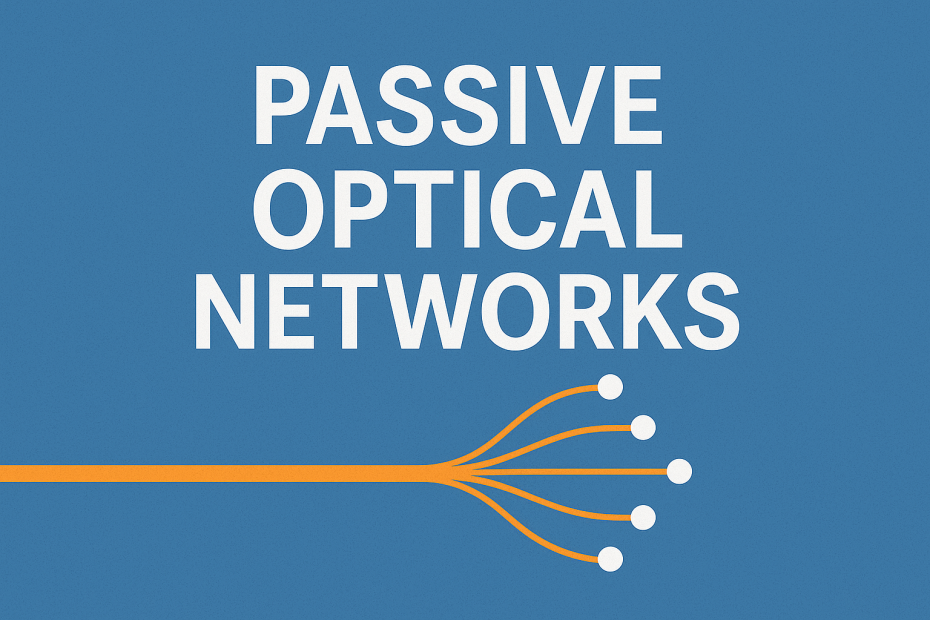
Pingback: Cisco CCNP SPCOR - Complete Blog Series Index - RichardKilleen